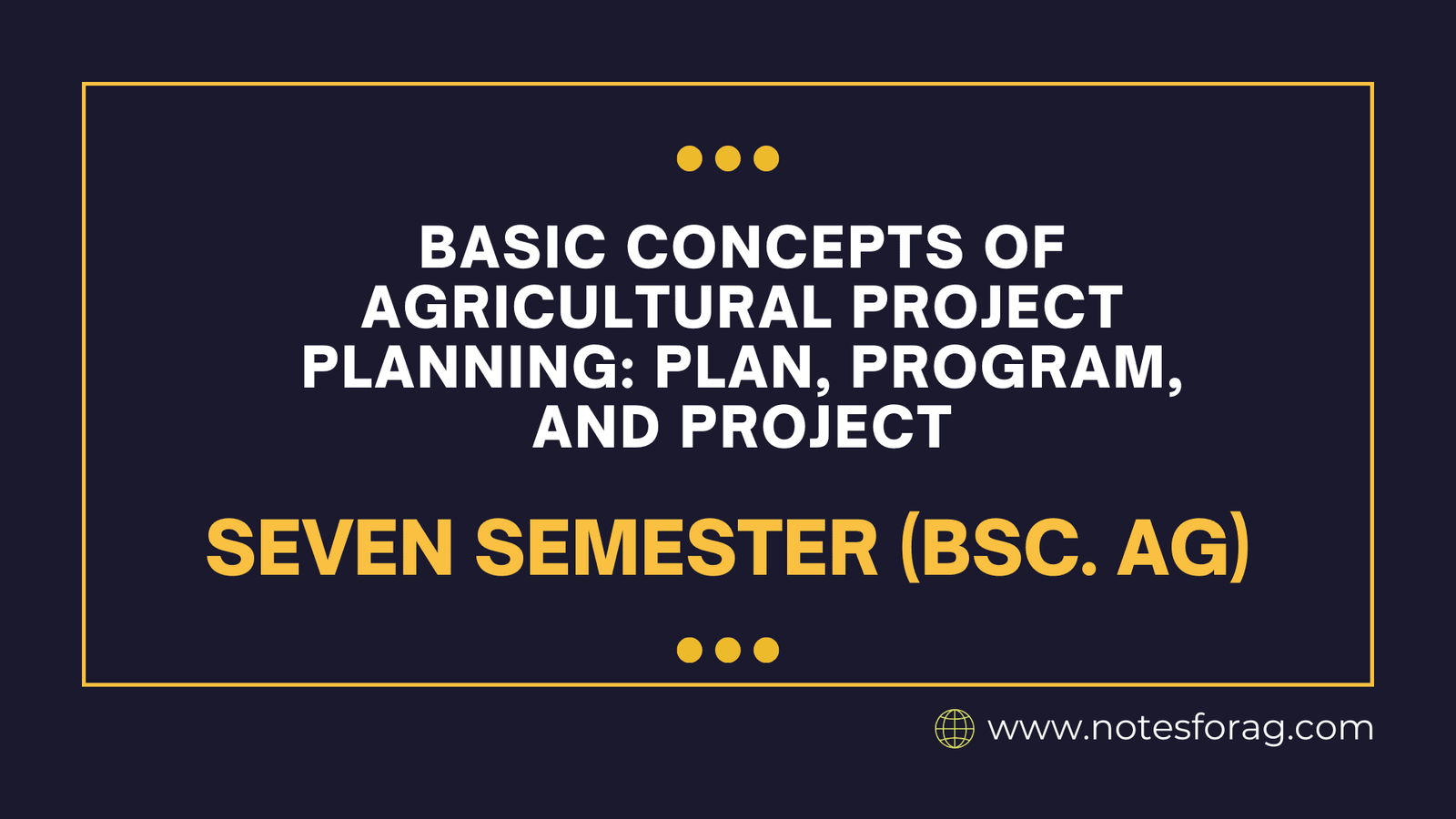What is Agricultural Project Planning?
Agricultural project palnning is the process of creating, planning, and carrying out programs to enhance rural development, sustainability, and agricultural productivity is known as agricultural project planning. To accomplish specified goals in the agriculture sector, Agricultural project planning entails formulating strategic strategies, designing targeted projects, and implementing certain programs.

Agricultural project planning involves a structured approach to designing and implementing initiatives aimed at boosting agricultural productivity, sustainability, and community well-being. To understand how agricultural development is organized, it’s important to grasp the differences between a plan, program, and project. These terms represent different levels of planning, from broad goals to specific tasks.
Table of Contents
1. Plan
A plan refers to a long-term, comprehensive strategy that outlines the overall goals and vision for agricultural development. It sets the framework for addressing key challenges and opportunities within the agricultural sector.
An agricultural plan typically covers broad areas such as improving crop yields, managing natural resources, enhancing market access, and promoting sustainable practices. It is often developed by governments, organizations, or institutions, and aims to achieve large-scale objectives like food security, economic growth, and environmental sustainability over an extended period.
For example, a national agricultural plan might aim to:
- Increase crop productivity by introducing better farming techniques.
- Promote the efficient use of water resources for irrigation.
- Reduce poverty in rural areas by creating more agricultural jobs.
- Encourage organic farming to safeguard the environment.
The plan provides a roadmap for all agricultural activities and aligns with broader national or regional goals.
2. Program
A program is a more focused part of the overall plan. It consists of related projects or activities that target specific areas or objectives, contributing to the broader goals outlined in the plan. Programs are usually designed to tackle particular issues in agriculture, such as improving food security, supporting rural livelihoods, or promoting sustainable farming practices.
Programs are typically mid-term (lasting several years) and focus on more specific goals compared to the larger plan. They bring together multiple projects that work toward solving a common problem or achieving a shared objective. Programs are often funded by governments, international organizations, or NGOs, and involve collaboration among stakeholders like farmers, researchers, and policymakers.
For example, under a national agricultural plan, you might find programs such as:
Soil Fertility Improvement Program: Focused on enhancing soil quality through the use of organic fertilizers and conservation techniques.
Water Conservation Program: Promotes water-saving methods such as drip irrigation and rainwater harvesting.
Rural Development Program: Provides training and financial support to small farmers to adopt modern agricultural methods.
Each program consists of several projects that work together to achieve the specific aims of that program. For example, the Water Conservation Program may include projects to build small dams, educate farmers on water-saving techniques, and improve irrigation infrastructure.
3. Project
A project is the most specific and concrete part of agricultural planning. It is a set of defined activities with clear objectives, timelines, and budgets, aimed at solving a particular problem or achieving a specific goal. Projects tend to be localized, addressing specific issues within a particular area or community, and they are smaller in scale and duration compared to programs.
Projects are the building blocks that contribute to the success of programs, which in turn help achieve the overall goals of the agricultural plan. Each project has a set start and end date, with clear deliverables and outcomes. Projects require detailed planning and coordination to ensure they are completed successfully.
An example of an agricultural project planning might include:
Irrigation Improvement Project in Village Y: A project to install drip irrigation systems in a local community to increase water efficiency and boost crop yields.
Farmer Training Program: A project aimed at educating farmers on the benefits of organic farming and modern pest control techniques.
Demonstration Farm: A project that establishes a model farm where local farmers can observe sustainable farming practices in action.
Projects are designed to meet specific needs and solve targeted challenges. They are usually funded by a mix of local governments, international donors, or private entities, depending on the scope and expected impact.
Relationship Between Plan, Program, and Project
In agricultural development, the relationship between plans, programs, and projects is crucial. Each component follows a logical flow:
The plan sets the overarching vision and long-term goals for agricultural development at a national or regional level.
The program focuses on more specific areas within the plan, targeting particular sectors or issues and grouping together related projects.
The project is where concrete action happens. It involves the implementation of activities on the ground, with a specific goal in mind.
For the overall agricultural development effort to be successful, the projects must align with the program’s objectives, and the programs must contribute to the broader goals laid out in the plan. Misalignment at any level can reduce the effectiveness of the entire initiative.
Conclusion
In summary, agricultural project planning involves different levels of planning: plans, which set broad, long-term objectives; programs, which focus on specific areas within the plan; and projects, which involve detailed, local-level actions to achieve concrete results. These components work together to promote sustainable agricultural development, improve productivity, and enhance the livelihoods of rural communities. By understanding how they interact, Agricultural project planning becomes easier to ensure that agricultural projects are aligned with both local needs and national goals, ultimately leading to more successful outcomes for farmers, communities, and the environment.
Frequently Asked Questions(FAQ)
What is agricultural project planning?
Agricultural project planning refers to the process of designing, organizing, and implementing agricultural activities aimed at improving productivity, sustainability, and rural development. It involves strategic planning at different levels: creating a broad plan, developing specific programs, and executing detailed projects to meet the sector’s needs.
What is the difference between a plan, program, and project in agricultural project planning?
A plan is a comprehensive, long-term strategy that outlines the overall vision and goals for agricultural development. It serves as the foundation for all other activities.
A program is a targeted initiative within the plan, focusing on specific themes or objectives (e.g., food security or water management) over the medium term.
A project is a concrete set of activities within a program, with defined objectives, timelines, and budgets, aimed at solving particular problems on the ground.
Related Articles

